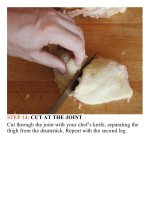The food lab better home cooking through science ( PDFDrive ) 776
Bạn đang xem bản rút gọn của tài liệu. Xem và tải ngay bản đầy đủ của tài liệu tại đây (178.89 KB, 2 trang )
Ifsearingdoesinfact“lockinjuices,”wewouldexpectthat
thesteakthatwasfirstsearedandthenroastedwouldretain
morejuicesthanthesteakthatwasroastedandthenseared.
Unfortunately for old wives’ tales, the exact opposite was
the case. I carefully weighed each roast at each step of the
processtogaugetheamountofmoistureandfatlostduring
cooking.Thesearetheresults:
The meat that was seared first and then roasted lost 1.68
percent more juices than the one that was roasted and then
seared. It’s not a huge difference, but the knowledge that
searingconclusivelydoesnotlockinjuiceswasliberatingin
thewaysthatitallowedmetothinkabouttherecipe.
Score:
•CommandmentI:PerfectCrust?Check.
•CommandmentII:NoGrayZone?Negative.
•CommandmentIII:Full-onJuiciness?Check.
InsideandOut
So, great, you may be thinking—you can sear first or you
can sear afterward, and it makes no difference.What’s the
big deal? Well, the big deal, as some of the more astute
readersmayhavenoticedinlookingatthetimingabove,is
thatifyoustartwitharawroast,ittakesaround15minutes
in the hot pan to get a well-browned crust, during which
time the outer layers of the roast are busy heating up and
overcooking, just like they did when roasted in a 400°F
oven.Buttogetawell-brownedcrustaftertheprimeribhas
been roasted, you need only around 8 minutes in the pan.
Whyisthis?
Itallhastodowithwater.
In order for the surface of a roast to reach temperatures
above the boiling point of water (212°F), it must first
become completely desiccated. When you sear raw meat,
abouthalfofitsstayintheskilletisspentjustgettingridof
excess moisture before browning can even begin to occur.
Youknowthatvigoroussizzlingsoundwhenasteakhitsa









